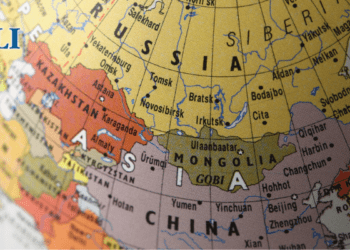 By joining the Asian Infrastructure Investment Bank, Canada is helping pivot the world economy away from the US, writes Philip Cross.
By joining the Asian Infrastructure Investment Bank, Canada is helping pivot the world economy away from the US, writes Philip Cross.
By Philip Cross, Dec. 6, 2017
Attention has recently focused on Trudeau’s visit to China and its continuing “exploratory discussions” of a possible free trade deal.
The wisdom of the government’s haphazard approach can be questioned, especially given its decision to eschew efforts at building consensus in the renewed Trans-Pacific Partnership negotiations prior to dealing with China. Instead, it favoured going one-on-one to negotiate with China alone – something not even the Americans have been comfortable doing. The results were predictable, if embarrassing.
Yet, as attention focuses on free trade, we also need to remember other elements of the Liberal government approach to China – some of which will likely prove equally troubling.
A good example can be found in the government’s budget bill from last month, which included a new law called the Asian Infrastructure Investment Bank Agreement Act. This law would set the terms for Canada’s involvement in the Asian Infrastructure Investment Bank (AIIB), fulfilling a promise from earlier in the year about joining this Chinese-led initiative.
The government has been eager to improve economic ties with Beijing – and the decision to join the Bank is only one element of that approach. Yet that raises important questions about the nature of the AIIB and the wisdom of actually joining this new institution.
The AIIB is a Chinese-founded alternative to the US-led World Bank. Yet it is far from clear why Canada wants to help pivot the world economy away from the US to China. Nor is it clear there is a shortage of capital in Asia that Canada needs to help finance, especially at a time when plans are being made for a new Canadian Infrastructure Bank to make up for our own infrastructure deficit. While Asia’s infrastructure needs are massive, so is their available pool of capital as reflected in its large trade surpluses. Many Southeast Asian countries have savings and investment rates of over 30 percent or even 40 percent of GDP. Their priority should be finding a mechanism ensuring that capital is deployed where it is needed most.
The government has been eager to improve economic ties with Beijing – and the decision to join the Bank is only one element of that approach.
It is well-known that it is not the amount of investment the drives long-term growth, but the efficiency of investment. Many Asian countries like Thailand, Malaysia, Indonesia and Taiwan had high rates of investment leading up to the Asian crisis of 1997, but these investments (often state-directed as part of their industrial policy) did not pay off. Canada’s enthusiasm to have a place at the table when the AIIB chooses investments bodes ill that investment will be driven by market considerations alone. Canada and other late joiners to the AIIB appear motivated to get a share of the contracts for infrastructure work in the region. This suggests a certain cronyism is anticipated in the process of awarding contracts, with local citizens in Asia ultimately paying more for investments they may not value.
Why Asia’s emphasis on infrastructure? While good infrastructure is certainly necessary for sustained growth, maintaining growth beyond the early developmental phase requires an ability to move into consumer products with the flexibility and ability to adapt to rapidly changing consumer tastes. Japan and South Korea have auto and electronics companies that have demonstrated that capacity; China and other southeast Asian countries have not. It is not clear how investment in infrastructure helps make that leap.
Canada’s contribution to the AIIB appears premised on the idea that China inevitably will become one of the world’s dominant economic powers. This is far from a sure thing. Before the global financial crisis of 2008, its rapid growth was built on exports as it integrated its production into global supply chains. However, since 2009 it has relied more on domestic demand for growth, much of it fuelled by debt. This is not a sustainable foundation for growth.
In The Rise and Fall of Nations, Morgan Stanley’s Chief Global Strategist Ruchir Sharma observed that nations experiencing increases of over 50 percentage points in their debt to GDP ratio inevitably experience a prolonged period of slow growth, if not financial crisis. China’s debt to GDP ratio has almost doubled from 150 percent in 2007 to 282 percent (Canada has nearly kept pace with an increase from 250 percent to 350 percent). He predicts China faces poor growth prospects over the coming year as a result of its recent debt binges as well as steep population decline (partly due to its one-child policy).
Canada’s contribution to the AIIB appears premised on the idea that China inevitably will become one of the world’s dominant economic powers. This is far from a sure thing.
Projecting that China will be able to sustain its economic growth seems to echo claims by experts in the 1970s that the Soviet Union would surpass the United States, then in the 1980s that Japan was poised to become the world’s next superpower, and finally forecasts in the 1990s that the European Union would dominate. All of these predictions were wrong.
There are other reasons to be wary of increasing our reliance on China as the emerging power in Asia. Its policies are often the exact opposite of what economists usually advocate for economic growth. Rather than encouraging liberty and the free flow of thought with innovation protected by property rights, China controls its own Internet and social media, steals intellectual property, flouts WTO trade rules, manipulates its currency, initiates cyberattacks on nations and companies around the world, makes unsupported territorial claims in the South China Sea, engages in human rights violations, breeds rampant corruption and increasingly pursues a cult of personality instead of fostering democracy.
Even more than infrastructure or investment, growth in emerging market economies requires good institutions and governance, something China sorely lacks. It is not clear that the AIIB will help or retard the development of good institutions.
It became fashionable among the Davos elite to speak of a new Beijing Consensus on state-directed economic growth, the successor to the Washington Consensus over-emphasis on macroeconomic stability as a precursor of growth. Faith in the so-called Beijing Consensus peaked in 2014, just when the AIIB was being created. Belief in the Beijing Consensus was soon undercut by the sharp drop in growth in Emerging Market Economies in 2015, when slumping commodity prices and a strong US dollar revealed that this model of growth was ultimately premised on debt, the most precarious source of growth.
Even the Chinese seem to have lost faith in this path to growth, judging by the increasing amount of capital local investors are moving out of China – $1.7 trillion in 2015-2016, leading China to impose controls in 2017. Such capital flight by local investors also preceded the Asian financial crisis in 1997. The steady outflow of capital from China, including an unknown amount of funds into Canada’s housing market, reflects that China’s own leaders are skeptical about the continuation of economic growth and political stability in the future.
It is worth recalling that the breakthrough for growth in many emerging markets in recent decades was not remotely the result of successful investments made over time by multilateral institutions such as the World Bank. It reflected countries adopting capitalism, tentatively at first in China, then in Eastern Europe after 1989 and then increasingly around the world as nations realized it was institutions and not government-directed investments that drove economic growth.
China regularly uses the attraction of the sheer size of its market to intimidate foreign companies and governments from initiating cases against its habit of routinely ignoring WTO rules. This effectively reinforces and rewards China’ belief that it can make its own rules without consequences. Unfortunately for Canada, the US is also learning the lesson that access to its lucrative market gives it enormous clout in negotiating trade and security deals with its nominal allies. The actions of China and the US threaten the structure of liberalized international trade that has benefited Canada for decades.
Philip Cross is a Munk Senior Fellow with the Macdonald-Laurier Institute. He previously served as the Chief Economic Analyst for Statistics Canada, part of a 36-year career with the agency. This piece is based on his presentation to the House Finance Committee, Nov. 7, 2017.




